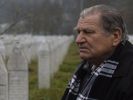Eye For Film >> Movies >> The Fog Of Srebrenica (2016) Film Review
The Fog Of Srebrenica
Reviewed by: Jennie Kermode

Looked at in the round, the facts of what happened in Srebrenica on the 11th of July 1995 are pretty well established, but some people still don't believe them. Perhaps they're too difficult to reconcile with the 'just a few bad apples' idea that lets Serbians live with it all in the aftermath. For people who lost dozens of their own family members - 67 in the case of the first man to share his story here - the idea that just a couple of thousand Bosnian Muslims died is impossible to accept, especially when the evidence suggests it was over 8,000. Emerging from the fog of war, fellow survivors have struggled to get anyone to listen to them. This documentary gives them a voice.
It's not an easy watch. There is little in the way of violence onscreen. We only see the aftermath of early assaults - incidents whose significance other Muslims, watching on TV, failed to recognise in time - and, more hauntingly, events leading up to the worst of the killing. Meanwhile, survivors talk. An elderly woman in her home, sitting beside a table laden with food she has clearly prepared for the crew - she has no relatives to spoil now. A barber at his place of work, his maleness, in combination with his age and ethnicity, immediately revealing the narrow escape he must have made. A young woman - she was 14 at the time, she says - who gives only her initials, her visage blurred, so that we know before she tells us that she's a survivor of military gang rape. And there are more. Hard faces, tired eyes. When they speak of how they used to be friends with the neighbours who turned on them, they sound as if they still can't quite believe it.

This is a film that keeps its story small and personal. The investigations, the war crimes tribunal, these are abstracted processes going on elsewhere, made tangible by a mother's question: did they find all of her son, or just parts of him? We don't see the shining corridors of power, the elegant meeting rooms in the Hague; instead we trace muddy tracks and unevenly paced streets where children used to play. Everything looks run down, especially on the farms, and gradually it becomes clear that there are no young people to undertake repairs. Although there is a lot of spoken material to absorb, it's often these visual details that convey the real scale of the damage. Mehanovic's camera traverses a literal fog and permits us the occasional glimpse of lingering natural beauty, the soul of the place which has inspired some of the survivors to return.
Nobody thought that such a thing could happen in Srebrenica. They thought that, since World War Two, humanity had become more civilised. This film serves as a map of the recent past and also as a warning about possible futures. Mehanovic's art lies in having taken such a huge, emotive subject and made it feel intimate and real.
Reviewed on: 28 Jun 2016

















